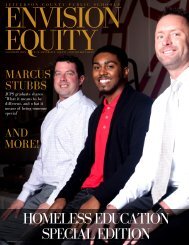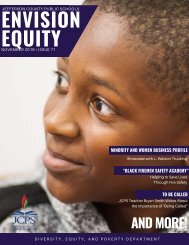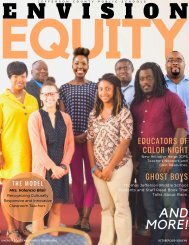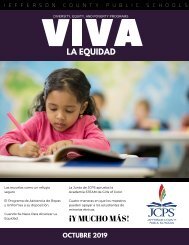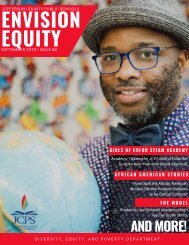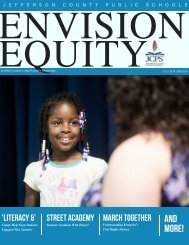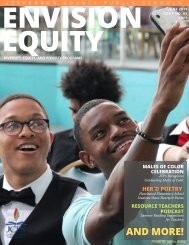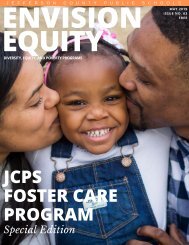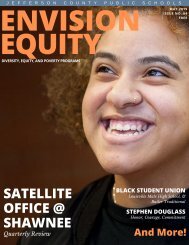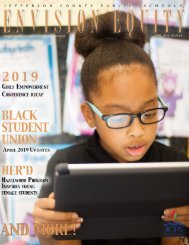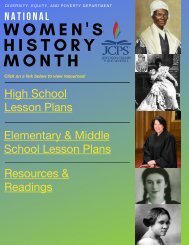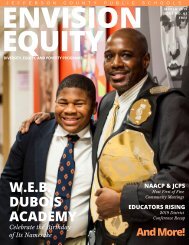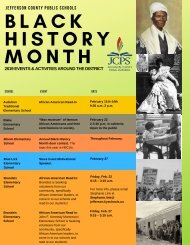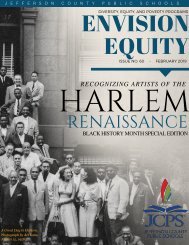August 2019 Envision Equity
Welcome back to school students & staff!
Welcome back to school students & staff!
Create successful ePaper yourself
Turn your PDF publications into a flip-book with our unique Google optimized e-Paper software.
ENVISION EQUITY<br />
Mr. Greg Vann, Generalist of Diversity<br />
JCPS Students Discover Their<br />
Identities During Summer Program<br />
10 Ways to Help Your Student Start<br />
the School Year on the Right Foot<br />
And More!<br />
1
GIRLS ON THE<br />
R.I.S.E.<br />
UNIVERSITY<br />
JCPS Students Discover<br />
Their Identities During<br />
Summer Program<br />
By Sylena Fishback—<br />
Coordinator, Volunteer<br />
Talent Center<br />
came together in<br />
a collaborative<br />
environment to<br />
present the Girls<br />
on the R.I.S.E.<br />
University<br />
experience held<br />
in the Shawnee<br />
Satellite Office!<br />
G<br />
irls on the R.I.S.E.<br />
(Revolutionizing<br />
Interpretations through Self-<br />
Expression) is an innovative<br />
literacy/art program that began in<br />
the summer of 2016 through the<br />
support of the office of Diversity,<br />
<strong>Equity</strong>, and Poverty Programs under<br />
the leadership of Dr. John Marshall.<br />
The program began at Frederick<br />
Law Olmsted Academy South with<br />
16 students and has since expanded<br />
to more than 160 students from<br />
various schools throughout the<br />
district. This summer, each school<br />
During the<br />
summer<br />
experience, the girls were exposed to five courses—Literacy, Art,<br />
Continue on next page<br />
2
Emotional<br />
Intelligence and<br />
Leadership,<br />
Math and<br />
Science, and<br />
History and<br />
Culture. This<br />
year’s focus was<br />
on identity<br />
awareness. In<br />
each course, the<br />
students<br />
explored a<br />
component of their identity. Students composed poems reflecting<br />
the experience of girls of color, created shields attributing various<br />
elements of their culture, created portraits embedding on zentangle<br />
designs, and planned out a lifestyle and budget according to their<br />
desired professions.<br />
While participating in the summer program, students engaged in a<br />
range of conversation, expressed well-supported ideas, probed<br />
ideas under discussion, and built upon others’ ideas. The students<br />
provided evidence of their learning at our Demonstration of<br />
Learning presentation on July 12. Students presented their projects<br />
and displayed their art work for parents, friends, and community<br />
members to view as a gallery walk through the hallways.<br />
Continue on next page<br />
3
Students traveled to Houston, TX, for their culminating learning<br />
experience. During the learning experience, students had the<br />
opportunity to attend the Main Stage Theater to view the play You’re<br />
a Good Man, Charlie Brown; dine at the exquisite Downtown Houston<br />
Aquarium; and explore the Houston Space Center, the Museum of<br />
Natural<br />
Science, and<br />
many more<br />
Houston<br />
attractions.<br />
Students also<br />
went on a<br />
tour of the<br />
University of<br />
Houston and<br />
were able to<br />
get a glimpse<br />
into student<br />
life on campus!<br />
The office of Diversity, <strong>Equity</strong>, and Poverty Programs is on a mission<br />
to build the confidence of girls of color, to create a school climate<br />
that fosters trust and respect, to encourage cooperation and inclusion<br />
in school communities, and to improve the academic achievement of<br />
4
ENVISION EQUITY AUGUST <strong>2019</strong><br />
Jefferson County Public Schools (JCPS) students. Our programs<br />
aim to enhance self-esteem in young girls by assisting them in<br />
recognizing their own strengths and providing an atmosphere in<br />
which teachers and role models cultivate students’ natural<br />
leadership skills. By doing this, we will equip young girls of color<br />
with the confidence, strength, and resilience to graduate prepared,<br />
empowered, and inspired to reach their full potential and<br />
contribute as thoughtful, responsible citizens of our diverse, shared<br />
world. If you are interested in starting a Girls on the R.I.S.E.<br />
program in your school during the <strong>2019</strong>-20 school year, please<br />
contact Sylena Fishback at 485-7967 or<br />
sylena.fishback@jefferson.kyschools.us.<br />
5
INTRODUCING<br />
Say “hello” to the newest member of team DEP!<br />
Name: Greg Vann<br />
Position: Generalist of Diversity<br />
T<br />
“Where your focus goes, your energy flows.”<br />
—Dr. Eric Thomas, motivational speaker.<br />
hat’s the quote that<br />
comes to mind when I<br />
think of my new opportunity<br />
with Jefferson County Public<br />
Schools (JCPS), because I am<br />
focused on continuing the<br />
positive change that the<br />
Diversity, <strong>Equity</strong>, and Poverty<br />
department is doing all across<br />
the district. My wife and I<br />
moved to Louisville for her<br />
career in February of 2018. I<br />
am joining JCPS from the<br />
Whitney M. Young Job Corps Center in Simpsonville, Kentucky.<br />
I’ve been with Job Corps for five years. I started at the Job Corps in<br />
Gulfport, Mississippi. That’s where we lived prior to moving to<br />
Kentucky. My three-year-old daughter, Gianna, was born there. We<br />
Continue on next page<br />
6
ENVISION EQUITY AUGUST <strong>2019</strong><br />
lived there for four<br />
years, but my wife<br />
and I are both from<br />
Middle Tennessee<br />
and wanted to be<br />
closer to family. I was<br />
born and raised in<br />
Clarksville, TN. I<br />
graduated from the<br />
University of<br />
Memphis where I<br />
pledged Alpha Phi<br />
Alpha Fraternity, Inc.<br />
This also means I am<br />
a huge Memphis<br />
Tigers fan. I’m a big<br />
sports fan in general.<br />
You can catch me<br />
cheering on the Los<br />
Angeles Lakers and<br />
Tennessee Titans! <br />
<br />
I’m very passionate about working with youth and changing<br />
lives. I’ve worked with youth in various capacities, starting with<br />
the City of Memphis Youth Services. I’m looking forward to<br />
working with DEP and using what I’ve learned to add to the<br />
great work JCPS is already doing.<br />
7
EDUCATORS<br />
RISING<br />
STUDENTS<br />
ENVISION EQUITY FEBRUARY <strong>2019</strong><br />
SHINE AT<br />
DALLAS<br />
NATIONAL<br />
CONFERENCE<br />
By Taylor Utley—Resource Teacher,<br />
Diversity, <strong>Equity</strong>, and Poverty<br />
Department<br />
8<br />
Continue<br />
Photos,<br />
on<br />
Taylor<br />
next page<br />
Utley
ENVISION EQUITY AUGUST <strong>2019</strong><br />
M<br />
ore than 1,300<br />
students and their<br />
teacher leaders came<br />
together in Dallas, Texas<br />
from June 22-25, <strong>2019</strong> to<br />
network, learn, compete and<br />
celebrate together. Sixteen of<br />
those students were from<br />
JCPS high schools Ballard,<br />
Waggoner, Fairdale, Central,<br />
and Seneca. Gathering<br />
together under the theme<br />
“There’s power in student<br />
voice” students and teacher<br />
leaders spent four days<br />
together learning, competing,<br />
and leading their own sessions as well as attending sessions<br />
keynoted by educator and author Jose Vilson and National<br />
Teacher of the Year Rodney Robinson.<br />
Educators Rising national competitions are performance-based<br />
competitive events in which teenage, aspiring teachers<br />
demonstrate their knowledge, skills, and leadership in education.<br />
With a blend of individual and team events, competitions are<br />
authentic, engaging opportunities for rising educators to stretch<br />
their creativity, commitment, and professionalism.<br />
Continue on next page<br />
9
ENVISION EQUITY AUGUST <strong>2019</strong><br />
In <strong>2019</strong>, Educators Rising offered 20<br />
national competitions. All competitions<br />
culminated with on-site presentations at<br />
the Educators Rising National<br />
Conference. Competition categories<br />
included Children’s Literature K-3 and<br />
Pre-K, Creative Lecture (TED Talk),<br />
Educators Rising, Leadership Award,<br />
Educators Rising Moment, Ethical<br />
Dilemma, Exploring Education<br />
Administration Careers, Exploring Non-Core Subject Teaching<br />
Careers, Exploring Support Services Careers, Impromptu<br />
Speaking, Inside Our Schools Presentation, Job Interview, Lesson<br />
Planning & Delivery – Arts, Career & Technical Education,<br />
Humanities, STEM, Public Speaking, and Researching Learning<br />
Challenges.<br />
Two JCPS students placed top ten overall in their perspective<br />
categories. Waggener High School’s November Offut, Junior<br />
placed top ten in the Lesson Planning- Arts and Humanities<br />
competition. She designed a lesson plan and submitted a video of<br />
her teaching the lesson to a freshman class at her school. The<br />
lesson was on Ethos, Pathos, and Logos, the modes of persuasion<br />
used to convince audiences. Grace Nobers, Ballard High School<br />
senior placed top ten in the job interview category.<br />
10
By Abdul Sharif—Generalist, Diversity, <strong>Equity</strong>, and Poverty Programs Department<br />
T<br />
he first day of school is<br />
just around the corner,<br />
and to help get students<br />
prepared and pumped up to<br />
head back to the classroom, the<br />
Jefferson County Public Schools<br />
(JCPS) Satellite Office @<br />
Shawnee is hosting a back-toschool<br />
celebration on <strong>August</strong><br />
1.<br />
JCPS Satellite<br />
Office @ Shawnee<br />
to Host Back-to-<br />
School Celebration<br />
In partnership with the Northwest Neighborhood Place, the JCPS<br />
Satellite Office @ Shawnee will provide students with school supplies<br />
and community resources, and students will be able to meet with the<br />
Parent Teacher Association (PTA) to learn more about the services it<br />
offers.<br />
Continue on next page<br />
11
Neighborhood Place is a partnership of Louisville Metro agencies<br />
and community residents who have come together to deliver services<br />
in a new way. The approach requires a unified action plan among<br />
diverse governments, agencies, and neighborhood residents. Because<br />
agencies are not competing with one another, they are in a position<br />
to maximize every resource available to them. The most significant<br />
benefit is to the families that Neighborhood Place serves. The<br />
Northwest Neighborhood Place is located right next to the JCPS<br />
Satellite Office @ Shawnee. Since the JCPS Satellite Office opened<br />
in Shawnee, the Neighborhood Place has been working hand-inhand<br />
with the Satellite Office to support JCPS students and families.<br />
The Back-to-School Bash is set to take place on <strong>August</strong> 1 at the<br />
JCPS Satellite Office @ Shawnee, 4018 W. Market Street, West<br />
Wing. The event will take place from 1 to 4 p.m. and is free and<br />
open to all families. For more information, please call 313-4881.<br />
12
ENVISION EQUITY FEBRUARY <strong>2019</strong><br />
ENVISION EQUITY AUGUST <strong>2019</strong><br />
Jefferson County<br />
Public Schools<br />
Black Student<br />
Unions Participate<br />
in Civil Rights Tour:<br />
Strength in Unity<br />
By Ellen Niehoff—Teacher, Central High<br />
Magnet Career Academy<br />
T<br />
Photos, Google Images.<br />
o end the 2018-<strong>2019</strong> school<br />
year, Black Student Union<br />
(BSU) students from Brown,<br />
Central and Manual went on a field<br />
trip to Alabama to visit some of the<br />
historic sites, museums and<br />
memorials of the Civil Rights<br />
Movement. Selma, Montgomery<br />
and Birmingham were the cities we<br />
visited. Like any field trip I have<br />
been on, the departing bus ride<br />
starts with a level of chatter<br />
amongst the students that quickly<br />
fades to sleep. This trip was no<br />
different, especially since we left so<br />
early in the morning. Once we<br />
stopped for lunch, the chatter and<br />
conversations reemerged. I could<br />
Continue on next page<br />
13
not help but listen to the<br />
various conversations<br />
students were having. As<br />
a teacher, I often inject<br />
my thoughts into a<br />
discussion or guide the<br />
discussion so we stay on<br />
topic. However, on the<br />
bus, I just listened. Our<br />
students had many<br />
opinions on various issues and problems in our community but often<br />
did not see themselves as part of the solution. Over the three days<br />
of our trip, I continued to listen to the students and it was<br />
empowering to see them realize that they can truly be part of the<br />
solution.<br />
Our first stop on our Civil Rights trip was Selma, Alabama. About<br />
an hour outside of Selma we watched a documentary on the bus<br />
about the local movement in Selma to gain voting rights. Many of<br />
my students have seen the movie Selma and associated the voting<br />
rights movement in Selma with the arrival of Dr. King. However, we<br />
learned that locals had been organizing and were the true catalyst<br />
for change. This showed our students that there was strength in<br />
unity. Once in Selma, we walked the Edmund Pettus Bridge. We<br />
were literally walking across history and the power of this was not<br />
lost by our students; they knew exactly what happened on March 7,<br />
1965. Once we made it across the bridge, a local gentleman greeted<br />
us and shared the history of the Civil Rights Movement in Selma.<br />
Hearing this history was powerful. We also learned that the bridge<br />
Continue on next page<br />
14
ENVISION EQUITY AUGUST <strong>2019</strong><br />
was named after a Confederate general and leader of the Alabama<br />
KKK, who later served in the Senate. This bridge was named to<br />
continue white supremacy and we saw first hand that when the<br />
people of Selma united together, they were able to defeat the ideals<br />
of white supremacy and gain voting rights.<br />
After Selma we<br />
went to<br />
Montgomery for<br />
what was<br />
honestly the<br />
most impactful<br />
part of the trip<br />
for my<br />
students. We<br />
visited both the<br />
Equal Justice Initiative Memorial and Museum. The National<br />
Memorial for Peace and Justice is a memorial dedicated to the<br />
legacy of enslaved black people, people terrorized by lynching,<br />
African Americans humiliated by racial segregation and Jim Crow,<br />
and people of color burdened with contemporary presumptions of<br />
guilt and police violence. At the memorial, students saw first hand<br />
the brutality of lynchings and white supremacy. We saw the victims<br />
of lynchings in Kentucky, our home. This impacted our students<br />
deeply. When we toured the museum, which was housed in a<br />
former slave warehouse, the realism hit our students. “It was so<br />
realistic I had to confront not only the past but where we are<br />
today,” Shania Jones said of the museum. Seeing the holograms of<br />
the enslaved and picking up the phone and hearing the words of<br />
Continue on next page<br />
15
ENVISION EQUITY AUGUST <strong>2019</strong><br />
individuals who<br />
are victims of mass<br />
incarceration was<br />
impactful.<br />
Later that evening<br />
we debriefed as a<br />
group and students<br />
had the<br />
opportunity to share their thoughts on what we had seen in our trip<br />
so far. Ms. Diane Courington from the Brown School and Mr.<br />
Peake from DuBois Academy did an excellent job of facilitating the<br />
discussion. Mr. James Miller and Dr. Geneva Stark also chimed in<br />
on the discussion and empowered students to make a difference in<br />
the spaces and places they occupy daily. The emotions of our<br />
students were raw and exposed but they did start seeing themselves<br />
as part of the solution. They saw how those who came before them<br />
united together and they saw how there was strength in unity.<br />
Our final day was spent in Birmingham. We first visited the<br />
Birmingham Civil Rights National Monument. In this park, we<br />
saw the statues and monuments dedicated to those who fought for<br />
Civil Rights in Birmingham. These were powerful, especially the<br />
statue of the four little girls who were killed in the bombing at the<br />
16th Street Baptist Church in 1963. We then toured the<br />
Birmingham Civil Rights Institute and learned from students the<br />
Continue on next page<br />
16
ENVISION EQUITY AUGUST <strong>2019</strong><br />
struggles of the Civil Rights Movement. We saw how the children<br />
of Birmingham united together to overthrow segregation in their<br />
city. We saw the strength that comes with unity. We ended our<br />
tour with visiting the 16th Street Baptist Church. This offered a<br />
place of quiet reflection as we ended our tour. We saw that with<br />
every struggle there is sacrifice.<br />
As we boarded the bus to come back to Louisville, I again<br />
listened to the conversations the students were having. These<br />
conversations were much different than the ones on the trip<br />
down. These conversations were more solution oriented. Before<br />
this trip, the BSU students of Brown, Central and Manual<br />
honestly did not know each other. This trip allowed them to the<br />
chance to get to know each other and become united. Instead of<br />
individual BSUs throughout the district, our students saw the<br />
strength that is gained when they unite together. As we move into<br />
this school year, I anticipate the BSUs across JCPS working<br />
together and coming up with solutions to some of the problems<br />
that face our district and community.<br />
17
ENVISION EQUITY AUGUST <strong>2019</strong><br />
A<br />
Application for<br />
pplications for the<br />
Muhammad Ali Center<br />
Council of Students<br />
Muhammad Ali (MACCS) and UCREW<br />
Social Entrepreneurship<br />
Center Youth programs for the<br />
<strong>2019</strong>-2020 school year are<br />
Programs Now<br />
open on the Muhammad<br />
Ali Center website. The<br />
Available<br />
MACCS program is open<br />
to high school sophomores<br />
through seniors, while<br />
UCREW is open to high school freshmen through seniors.<br />
The MACCS program is a<br />
diverse group of young<br />
leaders, committed to<br />
improving themselves and<br />
their communities through<br />
the practice of Muhammad<br />
Ali’s six core principles:<br />
Respect, Confidence,<br />
Conviction, Dedication,<br />
Spirituality, and Giving. As a<br />
youth-led organization, these<br />
dynamic students make decisions that guide the course of their<br />
service work and leadership development.<br />
18
ENVISION EQUITY AUGUST <strong>2019</strong><br />
UCREW is a ground-breaking social enterprise program of<br />
the Muhammad Ali Center available to high school students.<br />
The program offers a unique opportunity for students to not<br />
only learn about social entrepreneurship, but to work in teams<br />
to develop an actual social enterprise. During the school year,<br />
students will meet twice monthly to explore the issue of<br />
poverty in their communities and to reflect on ways to combat<br />
local poverty through creative business endeavors. By the end<br />
of the program, students will have conceptualized, produced,<br />
marketed, and launched a small social enterprise business.<br />
Students must be willing<br />
to commit to two<br />
meetings per month as<br />
well as participate in<br />
regularly scheduled<br />
community service<br />
projects.<br />
For more information on<br />
the MACCS program, please contact Darryl Young Jr.,<br />
Manager of Programming at 502-992-5311 or<br />
dyoung@alicenter.org, and for UCREW, Morgan Szabo,<br />
Programming Associate at 502-992-5312 or<br />
mszabo@alicenter.org.<br />
Application link: https://form.jotform.com/90975399332167<br />
19
ENVISION EQUITY AUGUST <strong>2019</strong><br />
Flash Dads<br />
Are Back for<br />
the <strong>2019</strong>-20<br />
School Year!<br />
By Abdul Sharif—Generalist, Diversity, <strong>Equity</strong>, and Poverty Programs Department<br />
W<br />
e are excited to announce that the third year of the<br />
Jefferson County Public Schools (JCPS) Flash Dads<br />
initiative will start on <strong>August</strong> 28 at 8 a.m. The Flash Dads<br />
program allows<br />
JCPS fathers,<br />
teachers, staff,<br />
alumni, local<br />
businessmen, and<br />
church leaders to<br />
get involved by<br />
greeting students<br />
as they exit the<br />
school bus in the<br />
morning. Flash<br />
Dads participants not only give students motivation in the<br />
morning but they also reinforce and emphasize the power of<br />
20
ENVISION EQUITY AUGUST <strong>2019</strong><br />
positive role models and<br />
community involvement across<br />
JCPS. This year, Flash Dads<br />
will be facilitated by Dr.<br />
Geneva Stark and will take<br />
place each month at an<br />
elementary school in JCPS. We<br />
cannot reveal the location of<br />
schools because we want each<br />
Flash Dads experience to be a surprise for JCPS students and<br />
staff, but if you would like to volunteer and want to know the<br />
next Flash Dads location, please contact Dr. Geneva Stark at<br />
485-3799 or geneva.stark@jefferson.kyschools.us.<br />
We hope to see you aboard the Flash Dads express this school<br />
year!<br />
21
ENVISION EQUITY AUGUST <strong>2019</strong><br />
18 Perfect Picture Books for<br />
the First Weeks of School<br />
Start off the first weeks of school right with the perfect picture book!<br />
By Elizabeth Mulvahill<br />
W<br />
e all know the first weeks of school with our students can<br />
truly set the stage for the entire year. Read-aloud books<br />
are a great way to facilitate class discussions, encourage<br />
students to feel comfortable sharing, and help you and your<br />
students establish which values will define your class’s identity.<br />
Here are some of our favorite back-to-school books, along with<br />
some follow-up activities, for the first few weeks in your<br />
classroom.<br />
22
1. The Day You Begin by Jacqueline Woodson<br />
(K–3)<br />
Star%ng fresh in a new environment, especially when you look around and<br />
think that nobody quite looks or sounds like you, can be scary. This lovely<br />
story will inspire your students to understand the gi>s of individuality.<br />
Follow-up ac%vity: Have your students play get-to-know-you bingo to find out<br />
just how much they have in common with their classmates.<br />
2. All Are Welcome by Alexandra Penfold (Pre-<br />
K–3)<br />
A lovely story that celebrates diversity and inclusion in a school where<br />
everyone, no maFer their dress or skin color, is welcomed with open<br />
arms.<br />
Follow-up ac%vity: Create an anchor chart of character traits. Brainstorm<br />
with your students all the ways they are alike and some of the ways they<br />
may be different.<br />
3. We Don’t Eat Our Classmates by Ryan T.<br />
Higgins (Pre-K–K)<br />
LiFle Penelope Rex is nervous about going to school for the first %me.<br />
She has some very important ques%ons: What are my classmates going<br />
to be like? Will they be nice? How many teeth will they have? LiFle ones,<br />
even liFle humans, will relate to this charming story.<br />
Follow-up ac%vity: Ask your students to share some of the ques%ons<br />
they wondered about before star%ng school.<br />
23
ENVISION EQUITY AUGUST <strong>2019</strong><br />
4. You’re Finally Here! by Melanie WaQ<br />
(Pre-K–2)<br />
A perfect first read-aloud book to show your students how excited you<br />
are to finally meet them! Follow along with the main character, Bunny, as<br />
he bounces through a hilarious range of emo%ons. All of your students<br />
will recognize the back-to-school feelings beneath the surface of this<br />
silly, in-your-face story.<br />
Follow-up ac%vity: Have students draw a self-portrait that shows the<br />
strongest emo%on they felt coming into school this year.<br />
5. First Day JiQers by Julie Danneberg (K–3)<br />
Everyone knows that sinking feeling in the pit of their stomach at the<br />
prospect of being the newbie. Sarah Hartwell is scared and doesn’t want to<br />
start over at a new school. She just knows it will be awful! She reluctantly<br />
pulls herself together and heads to school, where she meets a friend who<br />
helps smooth her transi%on. Kids will love the delighUul surprise ending of<br />
this sweet story!<br />
Follow-up ac%vity: Have students write about a %me they were scared and<br />
how their situa%on turned out! Or, have students partner with a friend and tell<br />
their stories to each other.<br />
6. The Name Jar by Yangsook Choi (Pre-K–3)<br />
When Unhei, a young Korean girl, arrives at her new school in the United<br />
States, she begins to wonder if she should also choose a new name. Does<br />
she need an American name? How will she choose? And what should she<br />
do about her Korean name? This heartwarming story speaks to anyone<br />
who has ever been the new kid or welcomed one into their familiar<br />
surroundings.<br />
Follow-up ac%vity: Have groups of students brainstorm 10 different ways<br />
they could make a new student feel welcome in class and create a poster<br />
to display.<br />
24
ENVISION EQUITY AUGUST <strong>2019</strong><br />
7. The ExcepXonally, Extraordinarily Ordinary<br />
First Day of School by Albert Lorenz (2–4)<br />
John is the new kid in school. When asked if the school is any different<br />
from his last one, he weaves a wildly crea%ve tale that captures the<br />
aFen%on of his new classmates. A hilarious story about conquering the<br />
fear of being the new kid.<br />
Follow-up ac%vity: Have students write a tall tale about what school was<br />
like last year to share with their new classmates.<br />
8. The Book with No Pictures by B.J. Novak<br />
(K–3)<br />
You might think a book with no pictures would be serious and boring,<br />
but this book has a catch! Everything, and we mean everything,<br />
wriFen on the page must be read out loud by the person reading the<br />
book, regardless of how goofy and preposterous it may be. Irresis%bly<br />
silly!<br />
Follow-up ac%vity: Have students work with a new friend or partner to<br />
create their own short book with no pictures. (Be sure to set clear<br />
parameters about content before le_ng students create.)<br />
9. Splat the Cat: Back to School, Splat! by Rob<br />
ScoQon (Pre-K–3)<br />
How can there be homework when it’s only the first day of school?<br />
Splat must pick only one of all of his fun summer adventures to<br />
share with his classmates at show-and-tell.<br />
Follow-up ac%vity: First day of school homework of course! Have<br />
students write about one of their favorite summer adventures.<br />
25
ENVISION EQUITY AUGUST <strong>2019</strong><br />
10. If You Take a Mouse to School by Laura<br />
Numeroff (Pre-K–2)<br />
You know the rou%ne … If you take a mouse to school, he’ll ask you<br />
for your lunch box. When you give him your lunch box, he’ll want a<br />
sandwich to go in it. Then he’ll need a notebook and some pencils.<br />
He’ll probably want to share your backpack, too. Another silly story<br />
from one of our favorite authors that is not only fun but lays the<br />
groundwork for teaching sequencing.<br />
Follow-up ac%vity: Using a long, narrow sheet of paper folded<br />
accordion style, have students create their own “If You Take … ” book.<br />
Students can build on the mouse story or create a character of their own.<br />
11. Dear Teacher by Amy Husband (Pre-K–3)<br />
This hilarious collec%on of leFers from Michael to his new teacher<br />
comes packed with alligators, pirates, rocket ships, and much, much<br />
more. Can Michael’s imagina%on save him from the first day of school?<br />
Follow-up ac%vity: Have students write a postcard to a friend or family<br />
member, telling about their fun first week of school!<br />
12. How to Get Your Teacher Ready by Jean<br />
Reagan (K–3)<br />
In a charming role reversal, the students in this story gently guide their<br />
teacher through the ge_ng-ready process for back to school. Your<br />
students will laugh and surely learn a lesson or two themselves.<br />
Follow-up ac%vity: Have students a compile a list of rules that will help<br />
the teacher have the best year ever.<br />
26
ENVISION EQUITY AUGUST <strong>2019</strong><br />
13. If You Ever Want to Bring an Alligator to<br />
School, Don’t by Elise Parsley (K–2)<br />
An alligator for show-and-tell sounds like TONS of fun. What could<br />
possibly go wrong? Magnolia is determined to have the best show-andtell<br />
ever. What will she do when her rep%lian pal starts wreaking havoc in<br />
the classroom? This hilarious story is sure to inspire even the most %mid<br />
of show-and-tellers.<br />
Follow-up ac%vity: Have students write a story or draw a picture about<br />
something outrageous they would bring to school for show-and-tell.<br />
14. This School Year Will Be the Best by Kay<br />
Winters (1–3)<br />
On the first day of school, new classmates are asked to share<br />
what they hope for in the upcoming year. The children’s<br />
wishes, from the familiar to the off the wall, are shown in<br />
humorously exaggerated illustra%ons. As the first day draws<br />
to a close, there can be no doubt this school year will<br />
definitely be the best!<br />
Follow-up ac%vity: Have students draw a star, put their name<br />
in the middle, and write one wish for the school year on each<br />
point (total of five). Then, have them loop a colorful ribbon through a hole on top to hang<br />
from the classroom ceiling.<br />
15. Back to School Rules by<br />
Laurie B. Friedman (K–3)<br />
School’s in session! When it comes to surviving school, Percy has<br />
ten simple rules that show there is more to school than showing up<br />
on %me and staying awake in class, including no spitballs, no running<br />
in the halls, and no crazy scheming! See what other trouble—and<br />
%ps—Percy has in mind!<br />
27
Follow-up ac%vity: As a whole class, brainstorm “rules” that will make this year the best ever.<br />
Then, have students transfer their ideas to a class promise poster that can hang prominently<br />
for the rest of the year. Have each student sign their name to make it official.<br />
16. David Goes to School by David Shannon<br />
(Pre-K–3)<br />
David’s an%cs in the classroom will make your students giggle with<br />
recogni%on. He’s so enthusias%c about being back to school! But David<br />
needs to learn that every classroom needs rules so that every student<br />
can learn.<br />
Follow-up ac%vity: Gather the whole class on the rug. Select a few<br />
students to act out a “bad” behavior and ask the other students to<br />
explain why the behavior is not okay for the classroom. Then have the<br />
same students act out the “good” behavior. Repeat with different sets of<br />
students to address different rules you are reinforcing in your classroom.<br />
17. A Place Called Kindergarten by Jessica<br />
Harper (K)<br />
Tommy’s barnyard friends are worried! He’s gone to a place called<br />
kindergarten. They wonder what will happen to him and if he will ever<br />
come back. Eventually, he returns with exci%ng tales of all the fun and<br />
learning he’s had.<br />
Follow-up ac%vity: Have your students take a “field trip” around the school<br />
to learn more about their new “barnyard.”<br />
18. Is Your Buffalo Ready for Kindergarten? by<br />
Audrey Vernick (K)<br />
Is your buffalo ready for kindergarten? Does he play nicely with friends?<br />
Check. Share his toys? Check. Is he smart? Check!<br />
Follow-up ac%vity: Follow along with Buffalo’s checklist in this hilarious look<br />
at first-day-of-school jiFers.<br />
28
ENVISION EQUITY JANUARY <strong>2019</strong><br />
JCPS Students<br />
Can Get Free<br />
Clothes<br />
Before First<br />
Day of School<br />
By Abdul Sharif—Generalist, Diversity, <strong>Equity</strong>, and Poverty Programs Department<br />
T<br />
hanks to generous donations received by the Jefferson County<br />
Public Schools’ (JCPS) Clothing Assistance Program (CAP)<br />
Office, JCPS students can receive free back to school supplies and<br />
clothes before the first day of school on <strong>August</strong> 14.<br />
Each student enrolled at JCPS is eligible to receive the following:<br />
• New pair of khaki or navy uniform pants<br />
• New polo-style uniform shirt<br />
Photos, Google Images<br />
• New belt<br />
Continue on next page<br />
29
• Five new pairs of white socks<br />
• Five new pairs of underwear<br />
In addition to the new uniforms, families are able to shop the<br />
assorted gently used clothing at CAP. All of these items are provided<br />
to families for free thanks to generous donors. To receive free clothes<br />
and supplies, families must call their child's school and ask about<br />
signing up for the clothing blitz, or they can call the district's office at<br />
485-3703.<br />
Alternatively, if you would like to donate clothing to the CAP office,<br />
please call bring your donation to the CAP office, located at Central<br />
Stadium, 319 S. 15th Street. The CAP office is open Monday<br />
through Friday from 9 a.m. to 4 p.m.<br />
Since 1971, the 15th District Parent Teacher Association (PTA) has<br />
operated the Clothing Assistance Program (CAP). It began when<br />
several moms noticed the lack of proper clothing on young students.<br />
Generous donors established a fund that purchases a new uniform<br />
shirt, a pair of pants, five pairs of socks and underwear, and a belt for<br />
each student who is referred to CAP. CAP serves about 10,000<br />
students each year.<br />
30
DON’T JUST BET ON BLACK<br />
By Bryan L. Smith—Teacher, Frederick Law Olmsted Academy North<br />
I<br />
t is no mistake that African American males are suspended at a<br />
higher rate. Do young men of color have a greater propensity for<br />
classroom dissonance? Is the correlation between the<br />
achievement gap and misbehavior a viable indicator for the<br />
educational decline for some minority males? No. School counselors<br />
have the technical skills to consult with teachers who desire effective<br />
strategies to support minority students who choose to display<br />
cognitive dissonance in the classroom. Without proactive<br />
consultations, the Bet on Black practice of some administrators and<br />
staff widens the Teaching Gap which should be identified as a worstpractice<br />
or malignant at best.<br />
Continue on next page<br />
31
Bet on Black is the belief or practice of placing challenging students<br />
of color in the classroom of the most melanous instructor as a best<br />
practice in closing the Teaching Gap. This ideology and pedagogical<br />
method must not be viewed as an effective solution for three<br />
reasons. First, there is a scarcity of minority teachers for systemic<br />
reasons. Second,<br />
the overloading<br />
of challenging<br />
students in<br />
minority or new<br />
teachers’<br />
classrooms<br />
impedes the<br />
recruitment or<br />
retention of any<br />
teacher-candidate<br />
or teacher. Third,<br />
the practice of Bet on Black supports a myth that the teaching gap<br />
can’t be closed with effective counselor consultations. It also entitles<br />
the privileged to ignore the social, emotional, and educational needs<br />
of some minority students. Frankly, the Bet on Black methodology<br />
dehumanizes teachers, students, and underserved communities.<br />
Through consultation, school counselors can assist teachers and<br />
administrators who struggle with challenging students. The practice<br />
Continue on next page<br />
32
of effective consulting empowers faculty members to identify the<br />
behavior patterns of students, to reflect on their perspectives and<br />
beliefs about the student’s dissonance, and to develop a plan or<br />
strategy to improve the student’s disposition while maintaining<br />
teacher-efficacy without engaging in a power struggle. WKU’s<br />
former student counseling professor Dr. Don Dinkmeyer<br />
condenses the consultation equation by stating that A and B work<br />
to change C through changes initiated by B’s beliefs and behaviors<br />
(p. 63, 2016). In summation, school counselors can close the<br />
Teaching Gap by consulting with teachers to recalibrating their<br />
perspectives and strategies for engaging students who may be<br />
dissonant in a classroom environment.<br />
Citations<br />
Dinkmeyer, Don Jr. (2016) Consultation: Creating School Based<br />
Interventions 4 th Ed. Routledge. Taylor & Francis Group, p. 63.<br />
33
ENVISION EQUITY AUGUST <strong>2019</strong><br />
<strong>August</strong> <strong>2019</strong><br />
Check out our monthly update video featuring JCPS Chief of<br />
Communications Renee Murphy, and Generalist, Abdul Sharif, to find<br />
out what DEP has coming up this month!<br />
Click Here to Play<br />
34
10 WAYS TO HELP YOUR STUDENT START THE<br />
SCHOOL YEAR ON THE RIGHT FOOT<br />
By Grace Chen<br />
Use these sage tips to ensure your children’s start to the school year is as smooth and<br />
trouble-free as possible.<br />
<br />
The upcoming school year brings a mix of emotions for kids and parents alike – from<br />
excitement over the promise of new beginnings to anxiety over the fear of the unknown. No<br />
matter how you child faces the new year, you can help him or her to make the most of the<br />
experience. These tips help you to help your child start the new school year on the right foot.<br />
Ease into a Schedule<br />
Most children spend their summers staying up late and sleeping in, which can make the<br />
adjustment to an earlier school schedule a bit of a shock to the system. Plan for a softer<br />
transition by easing children into the school schedule gradually during the last week or two of<br />
summer break. By pushing bedtimes up by one-half or one hour each week, your child will be<br />
better prepared to meet that first early bell with a smile.<br />
Plan to Eat Right<br />
PBS Parents recommends re-focusing summer eating habits that might have consisted of junk<br />
food on the run to healthy sit-down meals as a family whenever possible. When children spend<br />
many hours each day in a classroom, they need all the nutrition they can get to keep their<br />
brains in top performing condition. Begin with healthy breakfast selections, and try to have<br />
family dinner nights as often as possible throughout the week.<br />
Set Up a Homework Station<br />
Homework time will go that much more smoothly if all the necessary supplies are right at hand.<br />
Create a corner in the home, whether a desk in the bedroom or a space at the kitchen table,<br />
Continue on next page<br />
35
where kids have paper, pencils, erasers and other supplies within easy reach. Once the station is<br />
created, use it at the same time every day, establishing a study time after school without any<br />
electronic devices unless they are required for the assignment.<br />
Make the Proper Introductions<br />
If your child is apprehensive about the first day, plan to meet with teachers and school staff<br />
prior to that event. School Family recommends setting an appointment to meet the school<br />
principal, teacher and any support staff your child might come in contact regularly. Simply<br />
putting a face to a name can go far in easing a child’s first-day jitters – and a parent’s anxiety as<br />
well.<br />
Take a Tour<br />
If your child is starting a new school, a tour of the building will help him or her get the lay of<br />
land before that first bell rings. Some schools offer organized tours prior to the start of the year,<br />
but if they don’t, call the school and ask if you can schedule one. At the same time, do a<br />
practice run or two to and from the school so your child is comfortable with the route,<br />
particularly if he will be riding his bike or walking to school on his own.<br />
Get a Handle on the Curriculum<br />
Parents have many sources for learning about the curriculum that will be used in their child’s<br />
classroom during the upcoming year. An appointment with the teacher or principal is a good<br />
first step for collecting information. Some schools also feature orientation days where<br />
curriculum and goals for the classroom are reviewed. If the school doesn’t make the<br />
information available, the state department of education will also have curriculum information<br />
on their website.<br />
Get Involved<br />
If time allows, plan to get involved in your child’s school experience. Volunteer to help in the<br />
classroom, plan a class party or work in the lunchroom one day a week. There are many ways<br />
to get involved that allow you to observe your child in the school environment. If you are<br />
unable to volunteer, talk to your child every day about the school day and keep lines of<br />
communication with the teacher wide open.<br />
Continue on next page 36
Learn the Art of Organization<br />
Older students may need some help in the organization department if they want to be as<br />
successful academically as they can be. Create an organizational system for older students that<br />
makes it easy for them to track assignments and keep track of papers. Give the system a<br />
check-up once a week to ensure clutter doesn’t begin to build up. Clean out backpacks weekly<br />
as well to catch stray permission slips and homework assignments before they fall through the<br />
cracks.<br />
Teach Good Study Habits<br />
Another important component for success during the later years of school is the development<br />
of good study habits. Students need to explore study methods and practices that work for<br />
them and then employ those practices throughout the year. The most important fact to drive<br />
home is that daily study is much more effective than last-minute cramming – which some<br />
strong-willed students may have to learn the hard way.<br />
Keep it Positive<br />
The most important part of preparing for the upcoming school year is to keep a positive<br />
attitude about the experience. When parents show a positive attitude towards school and<br />
academics in general, students will tend to do so as well. Keep the end goal in sight – the<br />
wonderful opportunity to learn new things – and your children will be more likely to embrace<br />
the school experience.<br />
Getting ready to go back to school is a major event in most households across the country this<br />
time of year. With these tips in mind, parents will be ready to help their students face the<br />
challenges, excitement and changes the new school year will bring - and to really put parents'<br />
minds at ease, use these 10 signs to know if your child is indeed ready for the new school year.<br />
Continue on next page<br />
37
ENVISION EQUITY JANUARY <strong>2019</strong><br />
Literacy & Photography Students Create Works<br />
of Art at Burnett Avenue Baptist Church<br />
By Abdul Sharif—Generalist, Diversity, <strong>Equity</strong>, and Poverty Programs Department<br />
T<br />
Photos, Abdul Sharif<br />
his summer, ten Jefferson County Public Schools (JCPS) students<br />
had the opportunity to spend two weeks working with worldrenowned<br />
photographer Marvin Young during the Literacy &<br />
Photography summer camp held at Burnett Avenue Baptist Church.<br />
This was the first Literacy & Photography camp held at Burnett, and<br />
students used their time to soak up all the photography knowledge<br />
they could attain from Mr. Young. In addition to learning how to use<br />
cameras, students also spent most of their day reading and writing<br />
under the instruction of JCPS teacher Venita Burnett.<br />
Continue on next page<br />
38
During the closing program of<br />
the Literacy & Photography<br />
program at Burnett, students<br />
made a presentation to parents<br />
about famed photographer<br />
Dorthea Lange and her book<br />
Dorthea’s Eyes. Students spoke<br />
about how Lange started as a<br />
photographer who mainly focused on documenting the wealthy but<br />
transformed into a photographer who took photos of those on the<br />
lower end of the economic spectrum. Students learned how<br />
Dorothea's own sufferings with<br />
polio taught her the compassion<br />
and persistence she needed to<br />
communicate with her subjects.<br />
Dorothea's Eyes helped students see<br />
with their hearts and not just their<br />
eyes. In addition, students learned<br />
the history of the Great<br />
Depression with a selection of images at the back of the book that<br />
were both a historical record and a document of the rapport Lange<br />
achieved with migrant workers, an ex-slave, and men on a bread line.<br />
If you would like to see images that students created during the<br />
Literacy & Photography summer program, please click here to view<br />
their video presentation!<br />
Continue on next page<br />
39
T h e r e a r e o v e r 3 5 0<br />
s h o r t - t e r m t r a i n i n g<br />
p r o g r a m s o f f e r e d<br />
a c r o s s t h e s t a t e<br />
i n c l u d i n g :<br />
M e d i c a l a s s i s t a n t<br />
P a t i e n t c a r e t e c h<br />
A i r C o n d i t i o n i n g<br />
T e c h n o l o g y<br />
Did you know you can get trained for a high paying,<br />
in-demand job in four months or less, tuition free!<br />
Benefits of completing a short-term technical<br />
program:<br />
Increase your earning power! Starting<br />
salaries for those with certificates can be up<br />
to $40, 000!<br />
A u t o m o b i l e T e c h n i c i a n<br />
S u r g i c a l T e c h n i c i a n s<br />
P h y s i c a l T h e r a p y<br />
A s s i s t a n t s<br />
P i p e l i n e W e l d e r<br />
C o m p u t e r S u p p o r t<br />
T e c h n i c i a n<br />
Those with certificates can “stack” them and<br />
earn more $$$<br />
The Department for Community Based Services will<br />
provide a $250 gift card to any foster youth who<br />
earns a short-term technical certificate!<br />
D e n t a l A s s i s t i n g<br />
E l e c t r o n i c s<br />
M e d i a l C o d i n g<br />
E m e r g e n c y M e d i c a l<br />
T e c h n i c i a n ( E M T )<br />
For more information on available training<br />
programs at KCTCS visit:<br />
https://workreadykentucky.com/program_search<br />
R o u g h C a r p e n t e r<br />
P i p e l i n e W e l d e r<br />
I n d u s t r i a l M a i n t e n a n c e<br />
A n d m a n y m o r e !<br />
F i n d a c o m p r e h e n s i v e<br />
l i s t o f p r o g r a m s a t :<br />
h t t p s : / / w w w . k h e a a . c<br />
o m / p d f / w r k s _ a p p r o v<br />
e d _ p r o g r a m s . p d f<br />
To be eligible for the gift card, youth must be<br />
currently committed; Eligible programs include any<br />
short-term training program in a high-demand field,<br />
where youth can earn a certificate or diploma. The<br />
youth is eligible for the incentive after they have<br />
completed the program and passed the required<br />
industry certification test. For more information,<br />
contact: chafee.ilp@ky.gov.<br />
40
Community Invited to<br />
Attend Monthly JCPS/<br />
NAACP Community Forums<br />
By Abdul Sharif—Generalist, Diversity, <strong>Equity</strong>, and Poverty Programs Department<br />
s the opening of the<br />
<strong>2019</strong>-20 academic<br />
year approaches, the<br />
Education Committee of<br />
the Louisville Branch<br />
NAACP, in collaboration<br />
with the Diversity, <strong>Equity</strong>,<br />
and Poverty Programs Department, has organized a series of<br />
Community Forums. Starting in October, these monthly forums<br />
are designed to communicate openly and provide Information<br />
related to issues of access and opportunity for student success.<br />
They are viewed as a means to enlighten our membership and<br />
community about JCPS programs, policies, practices, and<br />
procedures.<br />
A<br />
Each forum will be hosted in Maupin Elementary School’s<br />
auditorium and will take place from 6 to 8 p.m. During each<br />
community forum, a JCPS representative will speak on issues<br />
related to access and opportunity for students.<br />
Continue on next page<br />
41
ENVISION EQUITY AUGUST <strong>2019</strong><br />
The schedule is as follows:<br />
• October 10—Dr. Marty Pollio, JCPS Superintendent<br />
• November 14—Dr. Carmen Coleman, JCPS Chief Academic Officer;<br />
Ms. Kim Chevalier, JCPS Exceptional Childhood Education; Dr<br />
Alicia Averette, Assistant Superintendent†of Academic Support<br />
Programs; and Dr. Felicia Cummings Smith, Assistant<br />
Superintendent for Teaching and Learning<br />
• December 9—Ms. Cordelia Hardin, JCPS Chief Financial Officer,<br />
and Mr. Jimmy Adams, JCPS Chief of Human Resources<br />
• January 9—Dr. Michael Raisor, JCPS Chief Operations Officer; Dr<br />
Devon Horton, JCPS Chief of Schools; and Cassiopeia Blausey,<br />
JCPS Director of School Choice<br />
• February 12—Dr. Katy DeFerrari, JCPS Assistant Superintendent<br />
of School Culture and Climate<br />
• March 13—Mr. Donald Dillard, JCPS Satellite Offices Supervisor;<br />
Mr. Delquan Dorsey, Community Engagement Coordinator; and<br />
Ms. Annie Haigler, Retired Administrator (JCPS Satellite Offices)<br />
For more information about the JCPS/NAACP Community<br />
Forums or to R.S.V.P., please contact Don Dillard at<br />
don.dillard@jefferson.kyschools.us or<br />
annie.haigler@jefferson.kyschools.us, or call 485-6787 if you<br />
need additional information.<br />
42
Series of JCPS Back-to-<br />
School Supply Events<br />
Planned for Students<br />
By Abdul Sharif—Generalist of Diversity, Diversity, <strong>Equity</strong>, and Poverty Dept.<br />
S<br />
tudents<br />
across the<br />
Jefferson<br />
County Public<br />
School (JCPS)<br />
District will<br />
have an<br />
opportunity to<br />
receive free<br />
school<br />
supplies at a<br />
dozen backto-school<br />
events scheduled throughout July and <strong>August</strong>. The events are<br />
sponsored by the JCPS Family Resource & Youth Services<br />
Centers and various community partners, including<br />
Neighborhood Place and the Louisville Metro Department of<br />
Community Services.<br />
All of the back-to-school events are free and open to the public.<br />
Students must be accompanied by an adult to receive supplies,<br />
Continue on next page<br />
43
ENVISION EQUITY AUGUST <strong>2019</strong><br />
and supplies are distributed on a first-come, first-served basis.<br />
School supplies, information and services vary by site.<br />
Back-to-School Festival at Cochran Elementary<br />
School<br />
WHAT: Open to families<br />
with children in<br />
kindergarten through high<br />
school. Free backpacks<br />
and essential gradeappropriate<br />
school<br />
supplies will be provided<br />
while supplies last.<br />
Vendors will be at this<br />
event providing essential<br />
health, education,<br />
employment and<br />
community resources. JCPS Family Youth Resource Center<br />
coordinators will complete CAP referrals for families needing<br />
clothing and uniform assistance. Free lunches will be served to<br />
kids by JCPS Nutrition Services. Children must be<br />
accompanied by a parent or guardian. This event is sponsored<br />
in collaboration with Bridges of Hope Neighborhood Place,<br />
Jefferson County Public Schools and Louisville Metro Office of<br />
Resilience and Community Services.<br />
Continue on next page<br />
44
ENVISION EQUITY AUGUST <strong>2019</strong><br />
WHERE: 500 W. Gaulbert Ave.<br />
WHEN: 11 a.m. to 2 p.m. <strong>August</strong> 2<br />
MORE INFORMATION: 502-634-6057<br />
Back-to-School Event at Meyzeek Middle School<br />
WHAT: Open to<br />
students<br />
kindergarten<br />
through high<br />
school. Free<br />
backpacks with<br />
essential school<br />
supplies for the<br />
coming year will be<br />
distributed while<br />
supplies last. Children must be present to receive school supplies.<br />
Smile Academy will provide free dental screenings. Local<br />
community vendors and agencies will be in the gym to provide<br />
information for families. Families may complete a CAP referral<br />
during the event as well for clothing and uniform assistance.<br />
Sponsored by Charmoli Center Neighborhood Place, Louisville<br />
Metro Office of Resilience and Community Services and area<br />
JCPS schools.<br />
Continue on next page<br />
45
ENVISION EQUITY AUGUST <strong>2019</strong><br />
WHERE: 828 S. Jackson St.<br />
WHEN: 10 a.m. to 1 p.m. <strong>August</strong> 3<br />
MORE INFORMATION: 502-313-4503<br />
Back-to-School Festival at Olmsted Academy North<br />
WHAT: Open to students in grades kindergarten through high<br />
school. Free backpacks, school supplies and health and hygiene<br />
products will be provided while supplies last. Children must be<br />
present to receive school supplies. The festival will also include<br />
vision and hearing screenings, blood pressure and diabetes<br />
checks, clothing assistance referrals and more. Lunch will be<br />
provided for children and adults. Sponsored by South Central<br />
Neighborhood Place, Diamond Cluster MC, 10 area JCPS<br />
Family Resource and Youth Service Centers, Louisville Metro<br />
Office of Resilience and Community Services, and Sts. Mary<br />
& Elizabeth Hospital.<br />
WHERE: 4530 Bellevue Ave.<br />
WHEN: 11 a.m. to 1 p.m. Saturday<br />
MORE INFORMATION: 502-313-4514<br />
46
ENVISION EQUITY AUGUST <strong>2019</strong><br />
How Can High-Poverty Schools Engage<br />
Families and the Community?<br />
High-poverty schools can involve students' families through home visits and by joining the<br />
community's safety net to provide social and medical services for those in need.<br />
By William Parrett and Kathleen Budge<br />
"I was headed to the home of one of my second graders to let the parents know that Luis was coming<br />
to after-school tutoring on time and doing well. When I knocked on the door, Grandma and Dad<br />
greeted me warmly in Spanish, inviting me in. Luis' mom was preparing dinner. Dad asked me to<br />
come directly to the kitchen to show me what Luis had begun doing at home since he started the<br />
tutoring program. On the cupboards were taped a mishmash of cereal boxes, pasta containers, dairy<br />
product holders, and simple drawings. All were in English. Dad smiled and explained, 'He's teaching<br />
all of us to read English! We learn five, maybe ten words every day!'" (Elementary teacher, highperforming,<br />
high-poverty school in the Northwest)<br />
T<br />
he story of Luis is a good example of the benefits of<br />
engaging parents and families. A simple home visit by the<br />
teacher revealed how, previously unbeknownst to the school, a<br />
young ESL student was connecting his tutoring and schoolwork<br />
with his family. In turn, Luis' family was most appreciative of<br />
their son's progress in school and welcomed his newly gained<br />
English skills that were helping them learn.<br />
Families living in poverty often work multiple jobs, may have<br />
limited English language skills, and in some cases may have had<br />
few positive experiences with their children's teachers or schools.<br />
These factors frequently work against a school's attempts to<br />
form relationships with families living in poverty and<br />
authentically engage them in their children's education. Even in<br />
47
ENVISION EQUITY AUGUST <strong>2019</strong><br />
high-performing schools, this problem is an ongoing concern.<br />
Leaders in high-performing, high-poverty (HP/HP) schools<br />
continually look for ways to provide opportunities for<br />
involvement and to gain back their trust.<br />
The Critical Importance of Trust<br />
In a recent study of public schools in Chicago, Anthony Bryk,<br />
president of the Carnegie Foundation for the Advancement of<br />
Teaching, and his colleagues concluded, "Relationships are the<br />
lifeblood of activity in a school community" (Bryk, Bender<br />
Sebring, Allensworth, Luppescu, & Easton, 2010, p.137). In one<br />
high-poverty elementary school, a teacher remarked, "Without a<br />
trusting environment in our classroom and with the families of<br />
my kids, it's all uphill. We never make the progress we could. . .<br />
we never can 'click.' Trust is what makes it all happen for us."<br />
The development of trusting relationships lies at the heart of<br />
successfully engaging parents, families, and the community.<br />
Here are seven strategies and practices to build trust between<br />
schools, students, and families.<br />
48
ENVISION EQUITY AUGUST <strong>2019</strong><br />
Create Full-Service Schools and Safety Nets<br />
Many HP/HP schools connect vital social and medical services<br />
with their students. These full-service schools typically provide<br />
services such as social workers, physicians, dentists, vision and<br />
hearing specialists, grief counselors, and family counselors on<br />
site. Some schools provide a childcare center, a family resource<br />
center, or hunger/homelessness support to assist families in<br />
meeting their basic needs. Research shows that when a fullservice<br />
school works well, student achievement increases,<br />
attendance rates go up, suspensions drop, and special education<br />
placements decrease (Dryfoos, 1994; Dryfoos & Maguire, 2002).<br />
Create Links Between School and Home<br />
Strengthening the family's ability to support their children's<br />
academic achievement and other forms of success in school is a<br />
priority in HP/HP schools. One school organizes a learning<br />
academy on Saturday mornings to assist families of refugee<br />
students. Other schools employ school-family liaisons who<br />
49
ENVISION EQUITY AUGUST <strong>2019</strong><br />
connect families with schools in a variety of ways. Sadowski<br />
(2004) identifies six activities that a school might consider to<br />
establish linkages between students' homes and school:<br />
1. Dual-language classes for students<br />
2. English as a second language, GED, and parenting classes<br />
3. Home-school liaisons (with fluency in the home language)<br />
4. Preschool and early literacy programs<br />
5. Early assessment<br />
6. Community and school activities and events<br />
Offer Mentoring to Students<br />
Most educators have long known that a meaningful<br />
relationship with an adult is what kids want and need most.<br />
Mentors provide such a relationship. The National Dropout<br />
Prevention Center identifies mentoring as one of the most<br />
effective strategies to keep kids engaged and in school. The<br />
Western Regional Center for Drug-Free Schools and<br />
Communities identifies five positive outcomes of mentoring<br />
programs (Jackson, 2002):<br />
1. Personalized attention and care<br />
50
ENVISION EQUITY AUGUST <strong>2019</strong><br />
2. Access to resources<br />
3. Positive/high expectations for staff and students<br />
4. Reciprocity and active youth participation<br />
5. Commitment<br />
Many HP/HP schools operate their own programs with local<br />
staff and volunteers; others access the help of Big Brother/Big<br />
Sister programs, local YMCA/YWCA services, and a host of<br />
other community-affiliated programs that offer adult<br />
mentoring.<br />
Provide Opportunity for Community-Based and Service<br />
Learning<br />
"Our kids actively work to support their community. Through<br />
clubs and classes, they raise money for families in need, work<br />
on a 'coats for kids' project, plant trees, build park benches,<br />
help with efforts of the Northwest Blood Center, Children's<br />
Miracle Network, American Cancer Society, March of Dimes,<br />
Red Cross, and many others. They rake leaves in our parks and<br />
do yard work for our elderly folks in need. Our students feel<br />
better because of these efforts, and our community values the<br />
extra help that the school gives back to them. When everyone<br />
is supporting one another, it makes Tekoa a great place to live<br />
and raise children." (Wayne Roellich, principal, Tekoa High<br />
School)<br />
51
ENVISION EQUITY AUGUST <strong>2019</strong><br />
Noted for connecting academic learning to real-world<br />
problems beyond school, community-based learning,<br />
particularly service learning, has become common in HP/<br />
HP schools. Many benefits accrue from service learning<br />
(Billig, 2000a, 2000b):<br />
• Enhanced academic achievement<br />
• Increased school attendance<br />
• Improved student motivation to learn<br />
• Decreased risky behaviors<br />
• Increased interpersonal development and student ability<br />
to relate to culturally diverse groups<br />
• Improved school image and public perception<br />
Community-based learning also provides an excellent means<br />
to initiate career exploration, internships, shadowing, and<br />
jobs.<br />
Conduct Home Visits<br />
Many HP/HP schools encourage and conduct some form of<br />
home visits. Fourteen years ago, test scores in the Mason<br />
County School District ranked in the lowest quartile of all<br />
districts in Kentucky. Inspired by the idea of building closer<br />
connections to students' home lives, the district, with a cadre<br />
of volunteer teachers, embarked on a goal of visiting every<br />
52
ENVISION EQUITY AUGUST <strong>2019</strong><br />
home of the 2,800<br />
kids enrolled.<br />
Maintaining this<br />
commitment over the<br />
years, together with<br />
positive<br />
administrative and<br />
collegial support and<br />
the requisite<br />
professional<br />
development, has resulted in every family receiving at least<br />
one home visit annually from their child's teacher. The<br />
district has experienced consecutive years of student<br />
achievement growth and a 50-percent drop in discipline<br />
referrals, as well as reduced achievement gaps and increased<br />
attendance.<br />
Ensure Effective Two-Way Communication<br />
We know that a "whatever it takes" attitude prevails in HP/<br />
HP schools. This is especially true in their efforts to<br />
communicate with the parents and families. Despite oftenlimited<br />
resources, educators in these schools make it a<br />
priority to develop authentic connections with students'<br />
parents and families. The goal of fostering two-way<br />
communication between school and home requires school<br />
leaders to be relentless in their insistence that<br />
communications be respectful, honest, and timely.<br />
53
ENVISION EQUITY AUGUST <strong>2019</strong><br />
Use the School as a Community Center<br />
Many HP/HP schools engage parents, families, and other<br />
community members by opening their doors and expanding<br />
their schedules to offer clubs, parent support and education,<br />
early childhood activities, GED programs, advisory groups,<br />
community education classes, and a host of other events and<br />
activities of interest to the community. These HP/HP<br />
schools partner with community or city organizations, local<br />
foundations, state and municipal agencies, service clubs,<br />
universities, and businesses to host these valued endeavors in<br />
their buildings, as well as offer services at times that better fit<br />
families' work schedules.<br />
The Principal's Role<br />
Principals, working with teacher-leaders and staff leaders<br />
from various vantage points within the school, are positioned<br />
to address the wide spectrum of environmental needs that<br />
confront high-poverty schools. HP/HP school principals can<br />
take a variety of actions (PDF) that will surround every<br />
student with the positive supports and scaffolds necessary to<br />
ensure his or her individual success.<br />
High-performing, high-poverty schools don't go it alone --<br />
and they don't reinvent the wheel. They access support,<br />
resources, and guidance whenever and wherever they can to<br />
foster a healthy, safe, and supportive learning environment.<br />
54
ENVISION EQUITY AUGUST <strong>2019</strong><br />
The resources and organizations listed below can guide a<br />
school's efforts to build strong relationships with parents<br />
and families:<br />
• Boys and Girls Clubs of America<br />
• Coalition for Community Schools<br />
• Communities in Schools<br />
• National Network of Partnership Schools<br />
• YMCA and YWCA Programs<br />
Action Advice<br />
• Monitor data to ensure a safe learning<br />
environment. Are we making sure that every student is<br />
always safe?<br />
• Build a common understanding of how poverty<br />
impacts learning. Do we all understand how living in<br />
poverty may negatively influence the ability of our<br />
underachieving students to catch up?<br />
• Plan for mobility. Are we ready for mobile students'<br />
arrival -- providing welcome packets, diagnostic<br />
testing, and appropriate placements? Do we develop<br />
"catch-up" plans if needed? Do we provide built-in<br />
55
ENVISION EQUITY AUGUST <strong>2019</strong><br />
opportunities for new friendships with peers? Do we<br />
make it a practice to communicate with parents<br />
during the first six weeks after enrollment? Do we<br />
address transportation issues if a student is mobile<br />
within our district?<br />
• Make sure that all students are connected to a caring<br />
adult. Do we know which students come to school<br />
without the support of a caring adult?<br />
• Start student advisories. Is every secondary student<br />
connected to an adult at school who regularly<br />
monitors his or her progress?<br />
• Personalize relationships through small learning<br />
environments. Is the size of our school presenting<br />
problems for some students and preventing us from<br />
forming caring relationships?<br />
• Provide opportunities for all students to participate in<br />
extracurricular activities. Do our students have an<br />
equitable opportunity to participate?<br />
• Work to engage every family with school. Do we have<br />
a plan in place for guiding our efforts to build trust<br />
and connect with our families?<br />
• Personalize the connection between school and the<br />
student's home. Who among our staff visits the homes<br />
of our kids?<br />
56
ENVISION EQUITY AUGUST <strong>2019</strong><br />
• Initiate an effective mentoring program. How are we<br />
connecting students with caring adults and positive role<br />
models?<br />
• Offer community-based learning and service-learning<br />
opportunities to all students. Are we connecting students<br />
with the community? Are we teaching students about the<br />
value of giving back? Are we providing opportunities for<br />
students to explore career options in the local<br />
community?<br />
• Visit every student's home. Do we have a plan in place to<br />
guide us in conducting productive home visits?<br />
• Ensure two-way communication between homes and<br />
school. This includes:<br />
◦ Language-appropriate written and verbal contacts<br />
◦ Translation assistance when needed<br />
◦ Respectful and clear communications<br />
◦ Frequent contact through the most effective mode<br />
◦ Authentic requests for feedback or response<br />
◦ Willingness to help with requests and family needs<br />
◦ Personal invitations to participate in school<br />
conferences<br />
◦ Timely invitations to activities and events<br />
57
ENVISION EQUITY AUGUST <strong>2019</strong><br />
• Open the school to the community. Have we created a<br />
plan to provide welcome and needed services to our<br />
community?<br />
• Join a network to enhance school, family, and community<br />
relationships. Can we improve our connections with our<br />
families and communities?<br />
Notes<br />
• Billig, S. (2000a). Educator's guide to collecting and using data:<br />
Conducting surveys.Denver, CO: RMC Research Corp.<br />
• Billig, S. (2000b). Profiles of success: Engaging young people's<br />
hearts and minds through service-learning. Berkeley, CA:<br />
Grantmaker Forum on Community & National Service.<br />
• Bryk, A.S., Bender Sebring, P., Allensworth, E.,<br />
Luppescu, S., & Easton, J.Q. (2010). Organizing schools for<br />
improvement: Lessons from Chicago. Chicago: University of<br />
Chicago Press.<br />
• Dryfoos, J.G. (1994). Full-service schools: A revolution in health<br />
and social service for children, youth, and families. San<br />
Francisco: Jossey-Bass.<br />
• Dryfoos, J.G., & Maguire, S. (2002). Inside full-service<br />
community schools. Thousand Oaks, CA: Corwin.<br />
• Jackson, Y. (2002). "Mentoring for delinquent children:<br />
An outcome study with young adolescent<br />
58
RED GRAMMER<br />
Supporting the Whole Child…. one world-class performance at a time<br />
Social Emotional Learning (SEL) · School Community · Anti-Bullying<br />
“This is the best cultural arts program I’ve seen in my 20 years of teaching!”<br />
Red Grammer infuses hope, joy and a sense of connectedness into every school he visits.<br />
His award-winning songs communicate themes of Perseverance, Compassion, Respect<br />
and Peacefulness in a language kids instantly understand and eagerly embrace.<br />
Featured on the Disney Channel, Nickelodeon, PBS, the Today Show and NPR.<br />
Click<br />
Here<br />
And see the power of<br />
a Red Grammer school visit<br />
59
ENVISION EQUITY AUGUST <strong>2019</strong><br />
“We highly recommend this gifted and<br />
energetic musician and educator to any<br />
elementary school looking to speak to<br />
children’s hearts regarding living a life of<br />
kindness.” Librarian, Clifton Park, NY<br />
“It was so wonderful to hear 900<br />
students and their teachers sing along to<br />
words that help us all live a life that is<br />
positive and focused on doing the right<br />
thing. This was just one of those days that I<br />
didn’t want to end.”<br />
Principal, Friendswood, TX<br />
“Red Grammer is a treasure and<br />
a gift! His visit to my school set a<br />
positive and uniAied tone for our<br />
entire school year.”<br />
Music Teacher, Waimea, HI<br />
“I marveled as I heard some<br />
comments made by the older children<br />
as they left the assembly. At that<br />
time, it was clear to me that the<br />
children had been empowered to<br />
turn some uncomfortable social<br />
situations into more productive ones<br />
through the implementation of some<br />
of the strategies taught through the<br />
presentation.”<br />
Principal, Wilmington, DE<br />
“Red Grammer is a delight…<br />
to listen to, but more importantly he<br />
is a man with a message for students,<br />
staff and parents.”<br />
Principal, at a Nat’l School of<br />
Character, Liverpool, NY<br />
Circle of Light<br />
Songs for<br />
Bucket Fillers<br />
Teaching Peace<br />
Songs of caring,<br />
conflict resolution<br />
& community<br />
Bebop Your Best!<br />
Music to Build<br />
Character By<br />
Programs<br />
(Click on program title for fuller description<br />
and song samples)<br />
Hello World!<br />
A Celebration of<br />
Geography<br />
& Oneness<br />
Want to bring Red Grammer<br />
to your school?<br />
Contact:<br />
Jan Stevens, Artist Representative<br />
818-639-2969<br />
janstevens@redgrammer.com<br />
60
ENVISION EQUITY AUGUST <strong>2019</strong><br />
KYTESOL Conference Accepting Proposals<br />
Proposals are being accepted for the <strong>2019</strong> Kentucky TESOL<br />
Conference, which will be held on October 4-5 at the JCPS ESL<br />
Newcomer Academy. The last date for submissions is <strong>August</strong> 2.<br />
More information, including the link for proposal submissions, can<br />
be found at https://kytesol.wildapricot.org. For additional details,<br />
contact Gwen Snow at gwen.snow@jefferson.kyschools.us or (502)<br />
485-6324.<br />
Creating New Futures for Newcomers<br />
The JCPS ESL Newcomer Academy was featured as a bright spot in<br />
the Mid-Atlantic <strong>Equity</strong> Consortium (MAEC) publication, “Creating<br />
New Futures for Newcomers.” The complete report can be read at<br />
https://maec.org/resource/creating-new-futures-for-newcomers/.<br />
The Louisville Urban League Presents:<br />
Super Saturday Soft Skills Series<br />
Saturday <strong>August</strong> 10th from 8:30 am – 12:30 pm<br />
@ the Louisville Urban League (1535 West Broadway)<br />
Topics Include: Time Management- Demetria Miles McDonald,<br />
Diversity Expert and Owner – Decide Diversity<br />
Teamwork- Ashlee Essex, Area Recruiting Manager – Rumpke Waste<br />
and Recycling. Personal Branding Using Social Media- Katie Coe,<br />
Senior Strategy Consultant – Papa Johns International<br />
Our Success Speaks guest speaker is Jackie Emerson, Product<br />
Marketing Lead – Humana<br />
This series is FREE to the community.<br />
61
ENVISION EQUITY AUGUST <strong>2019</strong><br />
BOOK STUDY<br />
WITH<br />
DR. CHERIE<br />
DAWSON-<br />
EDWARDS<br />
*Participants must attend<br />
all three sessions in order<br />
to receive PD credit.<br />
62
JEFFERSON COUNTY PUBLIC SCHOOLS<br />
SAVE<br />
09 2 6 19<br />
JCPS SATELLITE OFFICE @ SHAWNEE<br />
4018 WEST MARKET STREET (WEST WING)<br />
4:30 p.m.<br />
63
J E F F E R S O N C O U N T Y P U B L I C S C H O O L S<br />
D I V E R S I T Y , E Q U I T Y , A N D P O V E R T Y<br />
F L A S H D A D S<br />
Flash Dads will:<br />
•Pledge to support and encourage JCPS<br />
students at ten different schools located<br />
throughout Jefferson County.<br />
.•Be present once a month to greet students as<br />
they arrive at school in the morning.<br />
•Be a positive role model for our students.<br />
<strong>August</strong> 28, <strong>2019</strong><br />
September 26, <strong>2019</strong><br />
October 30, <strong>2019</strong><br />
November 20, <strong>2019</strong><br />
December: NO FLASH DADS<br />
DATES:<br />
January 29, 2020<br />
February 26, 2020<br />
March 25, 2020<br />
April 22, 2020<br />
May 13, 2020<br />
For more information, contact 485-3799.<br />
64
J E F F E R S O N C O U N T Y P U B L I C S C H O O L S<br />
DIVERSITY, EQUITY, AND POVERTY DEPARTMENT<br />
September 16 – OctOBER 21<br />
Mondays & Wednesdays<br />
3:30-5:30 p.m.<br />
Have fun while learning the skill of computer coding!<br />
EXPLORE THE WORLD OF COMPUTER CODING by participating in an<br />
innovative and interactive after-school program made possible through a<br />
partnership between Jefferson County Public Schools (JCPS) and the Academy of<br />
Music Production Education and Development (AMPED).<br />
When: Feb. 4, <strong>2019</strong>–March 28, <strong>2019</strong><br />
3:30–5:30 p.m.<br />
Where: JCPS Satellite Office @ Shawnee<br />
4018 W. Market St.<br />
Who: Middle School Students (space is limited)<br />
For more information, or to sign up, please contact Vanessa McPhail at<br />
485-8226 or email vanessa.mcphail@jefferson.kyschools.us.<br />
65
Coaching Students with DACA<br />
College Access<br />
DACA and undocumented students can go to<br />
KY colleges and universities.<br />
Per CPE policy KRS 13:0245 Section 8:<br />
• An undocumented student who graduates<br />
from a Kentucky high school can enroll at<br />
Kentucky colleges/universities as in-state<br />
residents for tuition purposes.<br />
Need help navigating the application process?<br />
Contact Assistant Director, Diversity<br />
Recruitment- Aimee Huffstetler<br />
502.852.1295, aimee.huffstetler@louisville.edu<br />
Scholarships<br />
These scholarships and resources are<br />
open to DACA, and in some other cases,<br />
undocumented students:<br />
» Migrant Network Collection<br />
» Hispanic Scholarship Fund<br />
» SHPE Foundation<br />
» Latino Student Resource Guide (LLEO)<br />
Resources<br />
» United We Dream (UWD)<br />
» Dream Educational Empowerment Program<br />
(DEEP)<br />
» Scholarships A-Z<br />
» My (Un)Documented Life<br />
Programs & Organizations<br />
The Latino Leadership and College Experience<br />
Camp is a local, community based program<br />
that provides college coaching and leadership<br />
development to Latinx and immigrant youth<br />
including undocumented and DACA students.<br />
For more information visit www.thellcec.org<br />
Kentucky Dream Coalition is an immigrant<br />
youth led organization focused on supporting<br />
the undocumented and DACA-mented youth<br />
and students in the state through organizing,<br />
workshops and mentoring.<br />
For more information visit www.facebook.com/<br />
kentuckydream/<br />
FAFSA<br />
Unfortunately, undocumented and DACA-mented students cannot<br />
receive state or federal financial aid.<br />
DACA students can complete the FAFSA for scholarship purposes.<br />
Step 1: Like all applicants, your first step should be to create an FSA<br />
ID for yourself and your family. If parents do not have a SSN do NOT<br />
create an FSA ID with an ITIN (individual tax identification number).<br />
Undocumented parents and students cannot create an FSA ID or use<br />
an ITIN on FAFSA forms at https://fsaid.ed.gov/npas/index.htm<br />
Step 2: There are 6 sections on the FAFSA: Student Demographics<br />
(which includes student eligibility), School Selection, Dependency<br />
Status, Parent Demographics, Financial Information and Sign & Submit.<br />
The two sections that are most confusing for DACA recipients are<br />
the Student Demographic section (particularly, the student eligibility<br />
questions) and Parent Information (if parents are undocumented).<br />
Step 3: Students can enter their income information manually or<br />
through the IRS retrieval tool if they filed taxes.<br />
Step 4: If the parents of a DACA recipient are undocumented, they<br />
must also not misrepresent themselves. When reporting parental<br />
information, do not use an ITIN in place of a Social Security Number.<br />
Parental information should be entered as follows:<br />
» A parent can complete FAFSA using “000-00-0000” for PARENT<br />
I SSN AND “999-99-9999” for PARENT II (Note: if parent holds<br />
ITIN to file taxes, do not use in place of SSN)<br />
» Parents’ income info must entered manually. Do not try to use the<br />
IRS Data Retrieval tool.<br />
» Because parents don’t have a SSN, they cannot create an FSA ID.<br />
Therefore, parents must print, sign, and mail in signature page.<br />
There is a bar code on the signature page that will match your<br />
parent’s signature to your specific application once the signature<br />
page is mailed into the FAFSA office listed on the signature page.<br />
There is no need to print the entire application. Just send in the<br />
signature page.<br />
Step 5: On the signature/submission pages, students can sign with<br />
their FSA ID. The parent must sign and mail in the signature page. For<br />
the <strong>2019</strong>-2020 school year, send the parent signature page to:<br />
Federal Student Aid Programs<br />
P.O. Box 7652<br />
London, KY 40472-7652<br />
Step 6: You will be able to check the status of your FAFSA online<br />
via www.fafsa.ed.gov with the same FSA ID and PIN number you<br />
created when you filed the FAFSA. Once the parent signature page is<br />
processed, you will be able to access your Student Aid Report (SAR)<br />
to view your EFC (expected family contribution), which is the number<br />
that demonstrates your need This information is important for needbased<br />
scholarships.<br />
Adapted from BCTC Latinx Outreach “Coaching Students with DACA”<br />
66
ENVISION EQUITY AUGUST <strong>2019</strong><br />
Books for Young Readers<br />
One is for Piñata: A book of numbers<br />
By Roseanne Greenfield Thong and John Parra<br />
(illustrator)<br />
Chronicle Books, <strong>2019</strong><br />
Ages 4-8<br />
A Scarf for Keiko<br />
By Ann Malaspina and Merrilee Liddiard<br />
(illustrator)<br />
Kar-Ben Pubishing, Inc., <strong>2019</strong><br />
Ages 5-10<br />
From the author and illustrator of Green is a Chile Pepper and<br />
Round is a Tortilla, One is for Piñata introduces numbers 1-10<br />
in English and Spanish. The items being counted are presented<br />
in Spanish with pronunciations and definitions available at the<br />
back of the book. Pura Belpre Honor recipient and illustrator<br />
John Parra’s bright illustrations show children and families<br />
celebrating holidays and daily life with an emphasis on Latin<br />
American culture.<br />
Lunch Counter Sit-Ins: How photographs helped<br />
foster peaceful civil rights protests<br />
By Danielle Llera-Smith<br />
Compass Point Books, <strong>2019</strong><br />
Grades 4-8<br />
Sam’s class is knitting scarves for U.S. soldiers fighting World<br />
War II. Suspicion of Japanese Americans runs high, so although<br />
Sam cannot seem to get his needles to create the stitches for the<br />
scarf, he refuses the help of his Japanese American classmate,<br />
Keiko, who knits beautifully. Sam feels badly when she is<br />
targeted by people throwing eggs, but Sam’s brother is fighting in<br />
the war. Wouldn’t it be disloyal to be kind to her? When Sam’s<br />
father shares that President Roosevelt is sending the Japanese<br />
Americans to internment camps, Sam is upset. He knows Keiko<br />
isn’t a spy. Sam’s father agrees. When Keiko is sent away, Sam<br />
decides to find a way to show Keiko that he cares for her.<br />
A Scarf for Keiko is a compelling story that puts a human face on<br />
both sides of this terrible chapter in American history. It includes<br />
author notes about Japanese internment camps during World War<br />
II that is honest in its assessment of the camps, but approachable<br />
for young readers.<br />
Lunch Counter Sit-Ins describes the role sit-ins and the press played in the<br />
Civil Rights Movement in the 1960’s. The book opens with the story of the<br />
Greensboro Four, four young men who began a peaceful protest of the<br />
Greensboro Woolworth’s policy not to serve African American customers<br />
at the lunch counter. It continues to discuss the history of the Civil Rights<br />
Movement, including some overlooked activists such as the young<br />
women who were students at Bennett College and not only supported<br />
and took part in the Greensboro sit-ins, but also helped to orchestrate the<br />
plan.<br />
Images obtained from Google Images..<br />
Book list provided by Heather Lee, Louisville Free Public Library.<br />
67
ENVISION EQUITY AUGUST <strong>2019</strong><br />
Title Session Code Date & Time Location Contact<br />
Regional Homeless<br />
Education<br />
Conference<br />
(Mandatory and<br />
Only for Homeless<br />
Liaisons)<br />
19-20103971 <strong>August</strong> 2<br />
8:00 a.m. to 2:00 p.m.<br />
Crown Plaza –<br />
Louisville Airport<br />
(830 Phillips Lane)<br />
Giselle Danger<br />
(502) 485-3650<br />
<strong>Equity</strong> and Inclusion<br />
Institute (for<br />
Accelerated<br />
Improvement<br />
Schools)<br />
19-20105005<br />
(morning session)<br />
19-20105194<br />
(afternoon session)<br />
<strong>August</strong> 5<br />
8:00 a.m. to 11:30 a.m.<br />
12:30 p.m. to 4:00 p.m.<br />
Kentucky<br />
International<br />
Convention Center<br />
(221 South 4 th Street)<br />
DEP<br />
(502) 485-3506<br />
SBDM: Introduction<br />
to School-Based<br />
Decision Making (for<br />
SBDM members<br />
only)<br />
19-20104883 <strong>August</strong> 6<br />
9:00 a.m. to 4:00 p.m.<br />
JCPS Satellite Office<br />
@ Shawnee<br />
(4018 W. Market<br />
Street)<br />
Dr. Shawna Stenton<br />
(502) 485-3056<br />
SBDM: Roles and<br />
Responsibilities of<br />
School Councils (for<br />
SBDM members<br />
only)<br />
19-20104920 <strong>August</strong> 6<br />
1:00 p.m. to 4:00 p.m.<br />
JCPS Satellite Office<br />
@ Shawnee<br />
(4018 W. Market<br />
Street)<br />
Dr. Shawna Stenton<br />
(502) 485-3056<br />
To view a complete list of DEP professional development sessions, visit https://www.jefferson.kyschools.us/node/1350<br />
68
ENVISION EQUITY AUGUST <strong>2019</strong><br />
Announcing...<br />
"The Model"<br />
Starting in the September edition of<br />
<strong>Envision</strong> <strong>Equity</strong>, we will highlight sample<br />
lesson plans and videos of Jefferson<br />
County Public Schools (JCPS) classroom<br />
teachers who are culturally responsive and<br />
innovative. This new section of <strong>Envision</strong><br />
<strong>Equity</strong> will be called “The Model.”<br />
If you are a JCPS teacher or know of a<br />
JCPS teacher who should be highlighted as<br />
a model of culturally responsive and<br />
innovative classroom practices, please<br />
submit his or her contact information to<br />
abdul.sharif2@jefferson.kyschools.us by<br />
the 15th of each month.<br />
Editor—Catherine Collesano<br />
Editor, Photo Contributor—Abdul Sharif<br />
Credits<br />
Special thanks to all of our community partners and educators who helped make this special edition of<br />
<strong>Envision</strong> <strong>Equity</strong> possible.<br />
<strong>Envision</strong> <strong>Equity</strong> is a publication of the JCPS Department of Diversity, <strong>Equity</strong>, and Poverty Programs. All<br />
submissions should be sent to Catherine Collesano at catherine.collesano@jefferson.kyschools.us or Abdul<br />
Sharif at abdul.sharif2@jefferson.kyschools.us. If you are interested in becoming a subscriber or a<br />
contributor to <strong>Envision</strong> <strong>Equity</strong>, please contact one of the editors at the above email address.<br />
www.jefferson.kyschools.us<br />
Equal Opportunity/Affirmative Action Employer Offering Equal Educational Opportunities<br />
69




